2013 Most Endangered
2013 Most Endangered List-- Additions and subtractions
Unfortunately, not much has changed with regard to the status of Landmarks' Most Endangered List since 2012. Because the list has not changed substantially, we present it here in summary format with status updates.
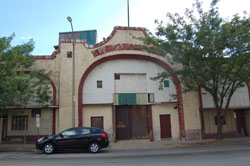 |
The St. Louis Palladium (aka Plantation Club) at 3618 Enright. Threats from a proposed expansion of the John Cochran VA Hospital continue to haunt future of this once prominent jazz club where the likes of Nat King Cole and Ella Fitzgerald once graced the stage. Among the last buildings in the thriving Grand Center Arts District still in need of rehabilitation, the Palladium's association with the early 20th century jazz scene in St. Louis perhaps could serve as an inspiration for a future use. The remarkable progress being made in the surrounding blocks, as evidenced by important ongoing rehabilitation projects such as the new home of KDHX Community Radio and the "Sun" Theater provides a glimmer of hope that this long-languishing landmark may yet have bright years ahead.
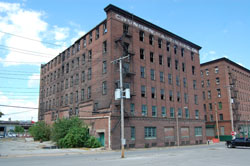 |
Crunden-Martin Manufacturing, 757 s. 2nd Street. Since a catastrophic fire in December of 2011 burned through the roof of this enormous warehouse building, the interior wooden structural system has been exposed to the elements. The building is currently in the same situation that resulted in the destabilization and eventual demolition of Cupples 7, and unfortunately appears to be headed down the same path. Despite the fact that the current condition of the building is in violation of city code, we are not aware of any efforts that have been made to repair the damaged roof or otherwise mitigate the deterioration.
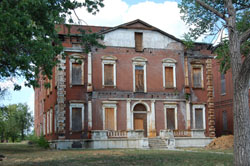 |
James Clemens Jr. House, 1849 Cass Avenue. This formerly grand mansion designed by Patrick Walsh for James Clemens Jr. in 1858 bears little resemblance to the home where a ceremonial signing of two aldermanic bills in support of developer Paul McKee's North Side Regeneration Plan took place in 2009. Now that the North Side project seems to have cleared the legal and political obstacles that have stood in its way for years, perhaps the original plan to restore the Clemens House can be salvaged before it is too late?
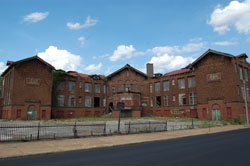 |
Carr School, 1421 Carr. Perhaps William Ittner's most beloved and interesting school, Carr has been abandoned for 30 years and shows it. While the building's angled wings still lovingly embrace the projecting kindergarten bay and Henry Chapman Mercer's mosaics still beautifully depict children at play, more than half of Carr's roof is gone and trees large enough to be used for dendrochronological dating purposes strive skyward to escape the gloom within. Another building located within the Northside Regeneration footprint, Paul McKee offered a glimmer of hope for Carr in October in testimony to the St. Louis Board of Aldermen when, according to the Post-Dispatch, he stated that he had plans to put a technology incubator into the school.
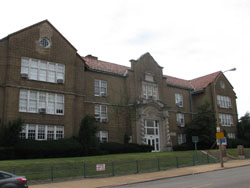 |
Shenandoah School, 3412 Shenandoah. While many St. Louis public schools are currently closed, or saddled with the threat of closure, only Shenandoah is currently being considered for demolition. Constructed in 1925 and designed by SLPS architect Rockwell Milligan, the Special Administrative Board that currently oversees the SLPS is considering destroying Shenandoah and constructing a new building on its site. Despite vocal opposition from neighborhood residents, the Mayor's Office, 6th Ward Alderwoman Christine Ingrassia, the elected SLPS Board, Landmarks Association and others, the SLPS is exempt from the city's preservation ordinance and there is no legal barrier to demolition.
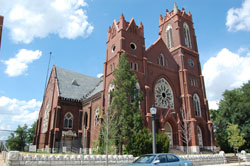 |
Bethlehem Lutheran Church, 2153 Salisbury. Located in the Hyde Park Historic District in North St. Louis this beautiful church is in a state of extreme disrepair due to lack of funds for maintenance. Many of the building's stained glass windows are missing, and copper flashing and gutters have been stolen allowing water to infiltrate its brick walls. Ivy has taken root at its base and is beginning to climb its towers and erode its mortar. Reconstructed in 1895 after a fire destroyed the original 1893 building, the church was designed by Louis Wessbecher. Unfortunately, the church's situation is representative of a larger pattern that exists in many areas of St. Louis and in older core areas across the country. As once centralized populations of congregants have spread out into a diffuse network of suburban churches the costs of maintaining the soaring cathedrals built by their ancestors are left to the diminished populations (and resources) that remain.
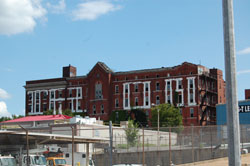 |
St. Mary's Infirmary, 1528 Papin "The condition of St. Mary's Infirmary is frightening -- anyone who has seen the side facing Chouteau Avenue lately has seen the ongoing collapse of the rear wall." So read the hospital's description in the Most Endangered List of 2009. Five years later, vandalism and neglect continue to take their toll. When the building was purchased for conversion to condominiums in 2005, the old hospital's future looked bright; then the economy faltered and the rehabilitation plan went with it. The main building, constructed in 1887-1896 (designed by Aloysius Gillick) would indeed be well-suited to residential reuse and the fully-leased City Hospital nearby (Georgian Condominiums) provides ample proof that a hospital-to-residential conversion can work in St. Louis. Unfortunately today, an emergency demolition of the decaying building is a more likely outcome.
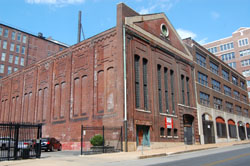 |
1711 Locust. This building was constructed in 1903 as a power substation for the St. Louis Transit Company, one of the major operators of the streetcar system. The architect is unknown, but Martin Arhelger was the contractor. The building was recognized as endangered in 2010 due to partial failure of its roof. Ironically, this was the same year that Landmarks sounded the alarm about the roof at Cupples 7, which was torn down earlier this year due to public safety concerns. The same building-killing process of water infiltration continues to erode 1711 Locust with telltale signs of water problems most obvious near the roofline of the west wall. With multiple examples of how a power house such as this can be reused around town, it would be a shame to lose such beautiful and versatile building.
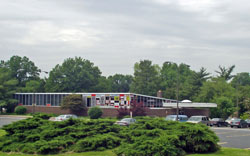 |
Lewis and Clark Library 9909 Lewis and Clark, St. Louis Co. Completed in 1963 and designed by noted modernist architect Frederick Dunn (FAIA) the library is slated for demolition and replacement as a component of Proposition L, which was passed by St. Louis County voters last year. The building is eligible for listing in the National Register of Historic Places for its significant design and also reflects a hopeful period of post-war growth in north St. Louis County. For a while it seemed that the voices advocating for a new addition and renovation of the library were making headway, but a letter from the President of the Board of Trustees of the SLPL system to the Chairman of the St. Louis County Historic Building's Commission dated October 1, 2013 indicates that demolition and replacement is once again the Board's preferred plan. * Image courtesy of www.beltstl.com
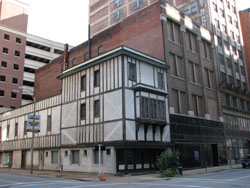 |
919 and 923 Locust. In August of 2013, a redevelopment plan was adopted which blighted and cleared the way for the demolition of the two buildings at the northeast corner of 10th and Locust. The destruction of these two buildings has been called a necessity by their owners, who wish to redevelop the building to the east, the former Scruggs Vandervoort Barney Annex at 917. The small corner building, beneath its late 20th century Tudor Revival cladding, may have portions that predate 1875. From 1912-1958, it housed the world-renowned Noonan-Kocian Art Company. The larger building at 923 (constructed in 1916 and designed by Nat Abrahams) was the longtime home of Leacock Sporting Goods. If demolished, the space the buildings presently occupy would be filled with some combination of landscaping, a semicircular drive, and modest lobby/drop off area. The buildings anchor one of the last fully intact four-way intersections left in the central business district and 919 in particular is the kind of small-scale, but highly adaptable building that downtown desperately needs more of.
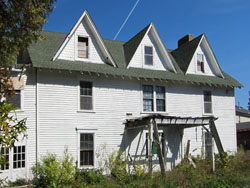 |
Woodside. 2200 Bredell, Maplewood, MO. Woodside was constructed c. 1849 by attorney and state senator Charles Rannells and his wife Mary. It may also have been constructed in whole or in part by the Rannells' slaves. Perhaps the oldest surviving home in Maplewood, Woodside is a remarkable physical reminder of ante-bellum agricultural life in St. Louis County and the outstanding amount of historical documentation the home and its former occupants enjoy make it a rare and valuable part of St. Louis history. For years local residents and the City of Maplewood have protected Woodside and worked tirelessly to find a developer who would take on the substantial work of rehabilitation to no avail. A recent decision by the Maplewood City Council in favor of demolition indicates that the building may have run out of time.
